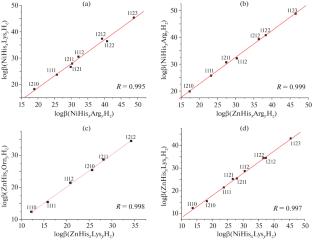水溶液中镍(II)和锌阳离子与组氨酸、赖氨酸和精氨酸的混合配体络合
IF 0.8
4区 化学
Q4 CHEMISTRY, PHYSICAL
引用次数: 0
摘要
用ph法和分光光度法研究了M(II)体系中不同组成的混合配体配合物的形成。计算了L-组氨酸(His) -L (M = Ni, Zn; L = L-赖氨酸(Lys), L-精氨酸(Arg))在298.15 K和离子强度I = 0.5 mol/L (KNO3)下的形成常数。通过对比例反应常数的比较分析,估计了配体的配牙性,并提出了混合配合物中氨基酸残基最可能的配位方式。本文章由计算机程序翻译,如有差异,请以英文原文为准。

Mixed-Ligand Complexation of Nickel(II) and Zinc Cations with Histidine, Lysine, and Arginine in Aqueous Solutions
The formation of mixed-ligand complexes of various compositions in M(II) systems is studied by means of pH-metry and spectrophotometry. L-histidine (His)–L (M = Ni, Zn; L = L-lysine (Lys), L-arginine (Arg)) and their constants of formation were calculated at 298.15 K and ionic strength I = 0.5 mol/L (KNO3). The ligand dentacy is estimated on the basis of a comparative analysis of the constants of proportionation reactions, and the most likely way of coordinating amino acid residues in the composition of mixed complexes is suggested.
求助全文
通过发布文献求助,成功后即可免费获取论文全文。
去求助
来源期刊
CiteScore
1.20
自引率
14.30%
发文量
376
审稿时长
5.1 months
期刊介绍:
Russian Journal of Physical Chemistry A. Focus on Chemistry (Zhurnal Fizicheskoi Khimii), founded in 1930, offers a comprehensive review of theoretical and experimental research from the Russian Academy of Sciences, leading research and academic centers from Russia and from all over the world.
Articles are devoted to chemical thermodynamics and thermochemistry, biophysical chemistry, photochemistry and magnetochemistry, materials structure, quantum chemistry, physical chemistry of nanomaterials and solutions, surface phenomena and adsorption, and methods and techniques of physicochemical studies.

 求助内容:
求助内容: 应助结果提醒方式:
应助结果提醒方式:


